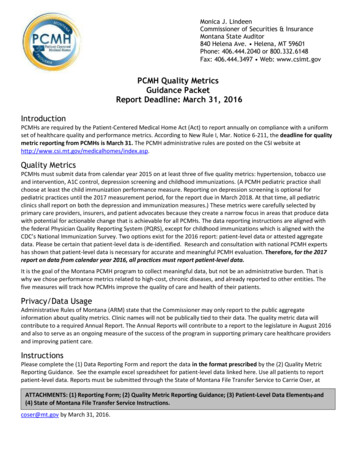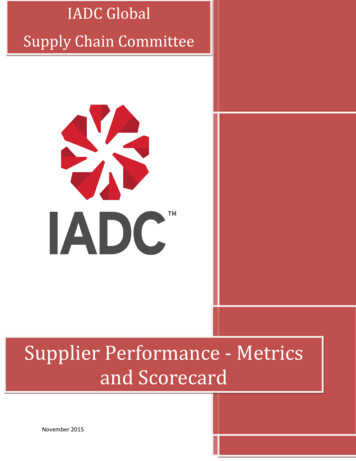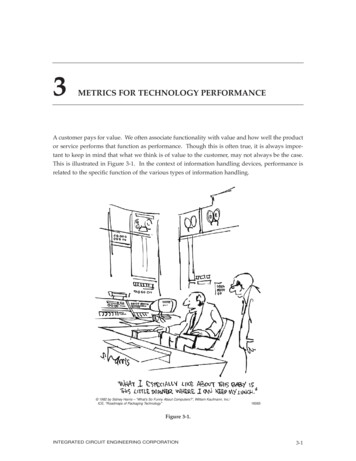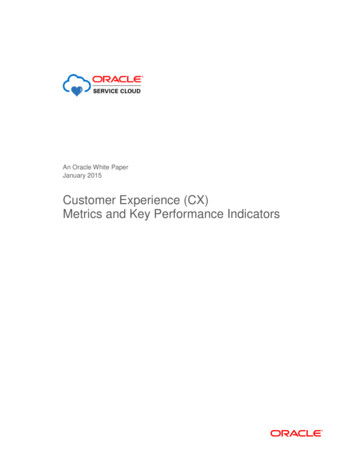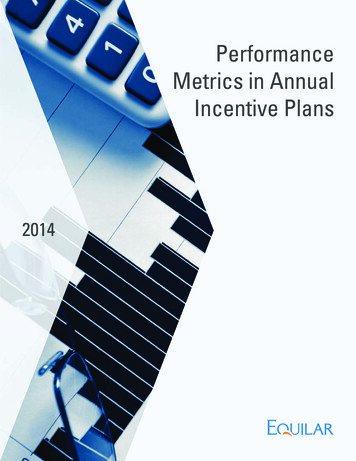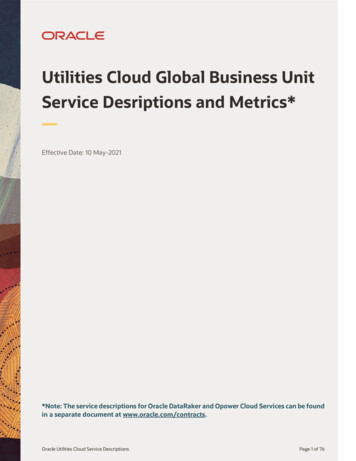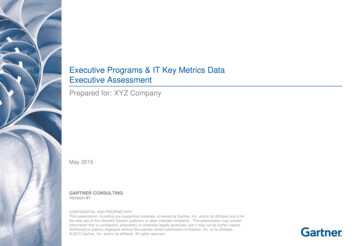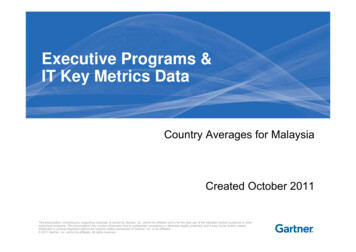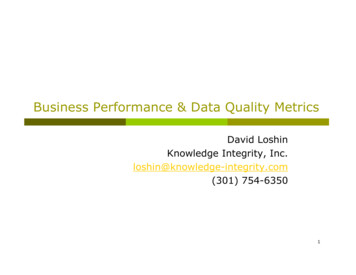
Transcription
Business Performance & Data Quality MetricsDavid LoshinKnowledge Integrity, Inc.loshin@knowledge-integrity.com(301) 754-63501
Does Data Integrity Imply Business Value? Assumption: improved data quality, “Master Data,” andintegrated reference data sets all imply business valueHowever, How are data quality metrics tied to business performance?How do you distinguish high impact from low impact dataintegrity issues?How do you isolate the source of the introduction of dataflaws to fix the process instead of correcting the data?How do you correlate business value with source dataintegrity?What is the best way to employ data integration bestpractices to address these questions? 2006 Knowledge Integrity, Inc.2
Managing Data Quality Benefits the EnterpriseData Quality ScorecardPrioritizing ImpactsRoot Cause AnalysisDecision-makingProductivity 2006 Knowledge Integrity, Inc.3
Business Impacts Regulatory or Legislative risk System Development risk Information Integration Risk Investment risk Health risk Privacy risk Competitive risk Fraud DetectionIncreased RiskDecreased RevenuesIncreased CostsLow Confidence Delayed/lost collections Customer attrition Lost opportunities Increased cost/volume Organizational trust issues Impaired decision-making Lowered predictability Detection and correction Prevention Spin control Scrap and rework Penalties Overpayments Increased resource costs System delays Increased workloads Increased process times Impaired forecasting Inconsistent management reporting 2006 Knowledge Integrity, Inc.4
Compounded EffectsThe Information Flow GraphDetermining the valueof fixing the processwhere the flaw isintroduced must becorrelated to the costof the eventualbusiness impacts.A data flaw introducedhere may be irrelevantBut you also have tofind out where theflaw is introduced!A data flaw introduced atthis processing stage propagates through thisprocessing stage and ultimately impacts businessresults at these stages 2006 Knowledge Integrity, Inc.5
Business Expectations and Data QualityBusiness ExpectationsData Quality rkMissing valuesFailed transactionsUnusable dataResponse to opportunities 2006 Knowledge Integrity, Inc.6
Business Expectations and Data Quality Data quality expectations are expressed as rules measuringcompleteness, consistency, validity of data values Business expectations are expressed as rules measuringperformance, productivity, efficiency of processes What data is missing or unusable?Which data values are in conflict?Which records are duplicated?What linkages are missing?How has throughput decreased due to errors?What percentage of time is spent in scrap and rework?What is the loss in value of transactions that failed due to missingdata?How quickly can we respond to business opportunities?Yet, to determine the true value added by data integrityprograms, conformance to business expectations should bemeasured in relation to its component data integrity rulesThis requires collaboration between the technical and businessteams, supported by senior management sponsorship 2006 Knowledge Integrity, Inc.7
Challenges Consumer data validation of supplied data provides littlevalue unless supplier has an incentive to improve itsproductDoes acquiring data from a third-party add value?Data errors introduced within the enterprise drain resourcesfor scrap and rework, yet the remediation process seldomresults in long-term improvementsReacting to data integrity issues by cleansing the data doesnot improve productivity or operational efficiencyAmbiguous data definitions and lack of data standardsprevents most effective use of centralized “source of truth”and limits automation of workflowProper data and application techniques must be employedto ensure ability to respond to business opportunitiesCentralization of integrated reference data opens uppossibilities for reuse, both of the data and the process 2006 Knowledge Integrity, Inc.8
Turning Data Quality into Process Quality Institute a data governance frameworkUse business-driven data validity assessment to baselinecurrent state and to measure ongoing improvementEstablish data quality issues tracking to improve internalremediation within an accountability chainDevelop a services-based approach to your centralizedreference master(s)Establish best practices for data management for otherenterprise data sets 2006 Knowledge Integrity, Inc.9
Data Governance Overseeing the people, processes, and technology to enablean organization to make best use of their information as avaluable resourceCoordinate: Correlation of data quality and achievement of businessobjectivesDirecting best practices for information managementStandardization of semantics, policies, and protocols acrossthe enterpriseMeasuring and reporting of qualification metrics of enterprisedata 2006 Knowledge Integrity, Inc.10
Finding Business Relevance Identify key business performance criteria related toinformation quality assuranceReview how data problems contribute to each businessimpactDetermine the frequency that each impact occursSum the measurable costs associated with each impactincurred by a data quality issueAssign an average cost to each occurrence of the problemValidate the evaluation within a data governance forum 2006 Knowledge Integrity, Inc.11
Root-Cause Analysis Impacts are typically associated with the discovery locationof a data quality problemIn fact, one impact may be related to a combination ofproblemsAlternately, a single problem may have multiple impactsA key to improving information quality is to identify theroot cause of problems and eliminate them at their sourcesA key to managing information quality include: Setting policies for data quality issue remediationEstablishing best practices for data managementDescribing protocols and service level agreements fordocumenting, tracking, and eliminating data quality issues 2006 Knowledge Integrity, Inc.12
Developing Metrics Develop metrics based on relationship of information torelevant business activities Master reference informationHuman capital productivityBusiness productivitySales channelService level complianceVision complianceBehaviorRisk 2006 Knowledge Integrity, Inc.13
Key Information Quality Indicators A key indicator reflects a rolled-up summary of someimportant aspect of the current state of the organization’sinformation qualitySample indicators: Number of unique reference data objects (e.g., customers,vendors, products) vs. duplicate entriesNumber of transaction “back outs”Financial inconsistenciesNull or missing data valuesExposures to risk 2006 Knowledge Integrity, Inc.14
Data Governance: Providing OversightThe processes, policies, standards, and technologies required tomanage and ensure the availability, accessibility, quality,consistency, auditability, and security of data within the organizationAccessibilityAll enterprise data relevant to the application can beaccessed regardless of source, structure, or formatAvailabilityData is available to data consumers and applications nomatter when, where, and how neededQualityThe accuracy, completeness, and validity of the data meetsor exceeds user expectationsConsistencyData semantics and values are consistent and reconcilableacross applications, processes, end organizationsAuditabilityThere is an audit trail captured on the dataSecurityAccess is secure and limited to approved users andapplications 2006 Knowledge Integrity, Inc.15
Data Governance LandscapePolicies and ProceduresRoles anceMetricsAudit &ComplianceStandardsData DefinitionsTaxonomiesMaster dsData IntegrationData QualityData ProfilingParsing &StandardizationData AccessDiscovery &AssessmentData CleansingRecord LinkageTransformationMetadataManagementAuditing &Monitoring 2006 Knowledge Integrity, Inc.Delivery16
Roles and Responsibilities Data Governance Oversight BoardData Coordination CouncilData Stewards 2006 Knowledge Integrity, Inc.17
Roles and ResponsibilitiesExecutive SponsorshipData Governance OversightData Coordination CouncilLOB Data GovernanceLOB Data GovernanceLOB Data GovernanceLOB Data GovernanceProvide senior management support at the C-level,warrants the enterprise adoption of measurably highquality data, and negotiates quality SLAs with externaldata suppliers.Strategic committee composed of business clients tooversee the governance program, ensure thatgovernance priorities are set and abided by, delineatesdata accountability.Tactical team tasked with ensuring that data activitieshave defined metrics and acceptance thresholds forquality meeting business client expectations, managesgovernance across lines of business, sets priorities forLOBs and communicates opportunities to theGovernance Oversight committee.Data governance structure at the line of business level,defines data quality criteria for LOB applications,delineates stewardship roles, reports activities andissues to Data Coordination Council 2006 Knowledge Integrity, Inc.18
Data Governance Oversight Board Guides activitiesApproves governance policiesOversees proper compliance with governanceReviews and Endorses/Approves policies and protocols 2006 Knowledge Integrity, Inc.19
Data Coordination Council Provides direction to those tasked with standardsdevelopmentAuthorize workgroup activitiesProvide direction for development of semantics,taxonomies, and ontologiesRecommend standards to the Oversight Board 2006 Knowledge Integrity, Inc.20
Data Steward Tasked with: Determining the relevant data sets that are relevant to thebusinessIdentifying correlation between data quality and achievementof business objectivesManaging data quality – techniques, tools, dimensions,tracking, reportingDocumenting, communicating, and tracking issues andconcerns to relevant stakeholdersVerifying the metadataAssume accountability for managing the quality of data 2006 Knowledge Integrity, Inc.21
A Process-Driven Approach to Data Quality1. Identify & Measurehow poor DataQuality obstructsBusiness Objectives5. Monitor Data QualityVersus Targets4. Implement QualityImprovement Methodsand ProcessesAnalyzeAnalyze2. Define businessrelated Data QualityRules & Targets3. Design QualityImprovement Processes thatremediate process flawsEnhanceEnhance 2006 Knowledge Integrity, Inc.Source: Informatica22
Data Quality Remediation & Data GovernanceImplementation (one off) OngoingRDBMSSource DQReporting & MgtFlat File4Profile andDataSourceand toAnalyze MultipleRemediated MapTargetStructureImproved Data QualitySourcesAudit & Reporton Master DataQuality3VSAMApplicationSource DQReporting & MgtIMSRisk DataGovernor5Build EnterpriseData QualityRulesReport DataQuality MetricsSource DataGovernors1ONGOING DATA QUALITYCLEANSING & MONITORINGPROFILING3Ongoing2Send Issue Reportsback to source 2006 Knowledge Integrity, Inc.Global DataGovernorDeploy RulesInteractive /Batch / RealtimeSource: Informatica23
Link a “DQ Scorecard” to Business Performance 2006 Knowledge Integrity, Inc.24
The Service-Oriented ApproachOpen Service ArchitectureData CleansingData IntegrationRules EngineGovernance ManagementReferenceDataMovement & DeliveryData AssessmentMetadata ManagementUniversal Data AccessAccessibilityProvides universal data accessAvailabilityHigh availabilityQualityCleansing and matching againstmaster reference entitiesConsistencyParsing, standardization, andtransformation using metadataAuditabilityInformation flow, audit trail, and datalineage capturedSecurityAccess is secure and limitedappropriately 2006 Knowledge Integrity, Inc.25
Business Data Quality Management Initiatives Establishing data quality monitoring and improvement as abusiness imperativeAcquiring, then deploying the proper tools, methods, andexpertise to improve the exploitation of referenceinformationTransitioning from a reactive to a proactive organizationwith respect to data qualityPrepare the organization to be a high-quality Master DataIntegration environment 2006 Knowledge Integrity, Inc.26
Getting Started With senior management sponsorship, pilot the identification of5 business objectives impacted by the quality of dataFor each of those business objectives: Determine performance metric to be communicated upwardCorrelate expectations for achieving that objective with a list ofdata validity or integrity rulesReview rules with senior management for agreement and sign-offon key metrics and data rulesApply rules using proper tools to assess baseline metricsIdentify and prioritize performance improvement targets, andselect most beneficial one to pilotUsing proper tools and methods, embed data qualitymonitoring and improvement within enterprise processesMonitor ongoing process improvement & correlate to businessobjectives 2006 Knowledge Integrity, Inc.27
Questions? If you have questions, comments, or suggestions, pleasecontact meDavid Loshin301-754-6350loshin@knowledge-integrity.com 2006 Knowledge Integrity, Inc.28
Business Data Quality Management Initiatives Establishing data quality monitoring and improvement as a business imperative Acquiring, then deploying the proper tools, methods, and expertise to improve the exploitation of reference information Transitioning from a reactive to a proactive o

